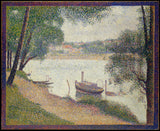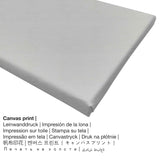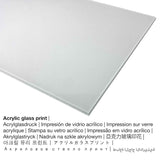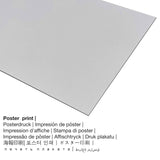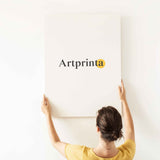Georges Seurat, 1886 - ihu igwe isi awọ, Grande Jatte - mbipụta nka mara mma
Ụtụ gụnyere. Mbupu gbakọrọ na ndenye ọpụpụ.
Nkọwa nke ihe nka ihe karịrị afọ 130
In the year 1886 Georges Seurat created the pointilist masterpiece. The original measures the size: 27 3/4 x 34 in (70,5 x 86,4 cm). Mmanụ na kwaaji was used by the European artist as the medium of the artwork. Nowadays, the piece of art forms part of the Ụlọ ihe ngosi nka nke Metropolitan mkpokọta nka. Nke nkà nke oge a ngalaba ọha A na-enye ihe osise na nkwanye ùgwù nke The Metropolitan Museum of Art, New York, The Walter H. na Leonore Annenberg mkpokọta, Onyinye nke Walter H. na Leonore Annenberg, 2002, Nkwenye nke Walter H. Annenberg, 2002. : Mkpokọta Walter H. na Leonore Annenberg, Onyinye nke Walter H. na Leonore Annenberg, 2002, Arịrịọ nke Walter H. Annenberg, 2002. Ọzọkwa, itinye n'usoro odida obodo format ma nwee oke nke 1.2: 1, nke pụtara na ogologo bụ 20% ogologo karịa obosara. The painter, drawer Georges Seurat was a European artist from France, whose style can primarily be classified as Pointillism. The Pointilist artist lived for a total of 32 years and was born in the year 1859 na Paris, Ile-de-France, France na nwụrụ na 1891 na Paris, Ile-de-France, France.
Họrọ ihe ị ga-ekwu
In the dropdown selection right next to the product offering you can select the size and materialaccording to your personal preferences. Choose among the following product options now to match your preferences in size and material:
- Mbipụta nke aluminom: Aluminium Dibond prints are metal prints with a true depth effect. Its non-reflective surface structure make a contemporary look. The bright and white sections of the work of art shine with a silk gloss but without the glow. Colors are bright and luminous in the highest definition, the details appear clear and crisp, and you can perceive a matte appearance of the print.
- Mbipụta iko acrylic (nke nwere ezigbo mkpuchi iko): The acrylic glass print, which is often described as a UV print on plexiglass, will turn your favorite original into wonderful décor. Your own version of the artwork will be made with the help of modern UV print technology. This has the impression of intense, stunning colors. The plexiglass protects your custom art replica against sunlight and heat for up to 60 years.
- Akwụkwọ mmado ebipụtara (ihe kwaaji): Our poster print is a UV printed canvas with a fine surface structure. Please keep in mind, that depending on the size of the poster we add a white margin of something between 2-6cm round about the print, which facilitates the framing with your custom frame.
- Mbipụta kwaaji: The printed canvas, not to be mistaken with a real canvas painting, is a digital copy printed on a canvas fabric. Canvas prints are relatively low in weight, meaning that it is quite simple to hang up your Canvas print without the support of any wall-mounts. A canvas print is suited for all kinds of walls.
Ozi dị mkpa: We try the best we can to depict our products with as many details as possible and to showcase them visually. Nonetheless, the pigments of the print products and the imprint may diverge marginally from the presentation on your monitor. Depending on your settings of your screen and the condition of the surface, not all colors can be printed as exactly as the digital version on this website. Bearing in mind that all the art reproductions are printed and processed by hand, there might also be slight differences in the size and exact position of the motif.
Tebụl edemede
| Bipụta ụdị ngwaahịa: | ọrụ mgbidi |
| Usoro mmeputakwa: | mmeputakwa n'ụdị dijitalụ |
| Production usoro: | UV kpọmkwem obibi |
| Ihe ngosi: | German mmepụta |
| Ụdị ngwaahịa: | mmepụta ihe na-achọ |
| A na-atụ aro iji ngwaahịa eme ihe: | nka mgbidi, gallery mgbidi |
| Nhazi: | nhazi odida obodo |
| Oke akụkụ: | ogologo: obosara - 1.2: 1 |
| Akụkụ akụkụ pụtara: | ogologo bụ 20% ogologo karịa obosara |
| Nhọrọ akwa: | Mbipụta iko acrylic (nwere ezigbo mkpuchi iko), mbipụta ọla (aluminium dibond), mbipụta akwa akwa, mbipụta akwụkwọ mmado (akwụkwọ kwaaji) |
| Ọdịiche dị n'okirikiri akwa akwa akwa (akwa akwa): | 60x50cm - 24x20", 120x100cm - 47x39", 180x150cm - 71x59" |
| Acrylic glass print (nwere ezigbo mkpuchi iko) nhọrọ: | 60x50cm - 24x20", 120x100cm - 47x39", 180x150cm - 71x59" |
| Nhọrọ nha nke akwụkwọ mmado (akwụkwọ kwaaji): | 60x50cm - 24x20", 120x100cm - 47x39" |
| Mbipụta nke aluminom (ihe aluminom): | 60x50cm - 24x20", 120x100cm - 47x39" |
| Nhazi mbipụta nka: | enweghị etiti |
Nkọwa ihe osise
| Aha nka: | "Gray Weather, Grande Jatte" |
| Nhazi nka: | sere |
| Otu izugbe: | nkà nke oge a |
| Nhazi oge: | 19th narị afọ |
| Emepụtara n'afọ: | 1886 |
| Afọ nka: | gbara afọ 130 |
| Ọkara nke ihe osise izizi: | mmanụ na kwaaji |
| Nha izizi nka: | 27 3/4 x 34 inch (70,5 x 86,4 cm) |
| Egosiputara na: | Museumlọ ihe ngosi nka nke Obodo |
| Ebe ebe ngosi nka: | New York City, New York, Njikota Obodo Amerika |
| website: | Museumlọ ihe ngosi nka nke Obodo |
| Akwụkwọ ikike nka: | ngalaba ọha |
| Site n'aka: | The Metropolitan Museum of Art, New York, The Walter H. na Leonore Annenberg mkpokọta, Onyinye nke Walter H. na Leonore Annenberg, 2002, Nkwenye nke Walter H. Annenberg, 2002 |
| kreditline ọrụ nka: | Mkpokọta Walter H. na Leonore Annenberg, Onyinye nke Walter H. na Leonore Annenberg, 2002, Arịrịọ nke Walter H. Annenberg, 2002 |
Ozi ndabere gbasara onye na-ese ihe
| Aha onye nka: | Georges Seurat |
| Aha ndị ọzọ: | Seurat Georges-Pierre, Georges Seurat, geo. seurat, seurat geo., g. Seurat, Hsiu-la, Seurat George Pierre, Seurat Georges, Seurat Georges Pierre, Georges-Pierre Seurat, סרא ז׳ורז, Seurat, geo seurat, Sera Zhorzh, Georges Pierre Seurat |
| Gender: | nwoke |
| Nationality: | French |
| Ọrụ onye na-ese ihe: | drawer, eserese |
| Mba onye si: | France |
| nhazi ọkwa: | omenkà nke oge a |
| Ụdị nke onye na-ese ihe: | Isi okwu |
| Oge ndu: | 32 afọ |
| Afọ ọmụmụ: | 1859 |
| Ebe omuma: | Paris, Ile-de-France, France |
| Nwuru: | 1891 |
| Nwụrụ na (ebe): | Paris, Ile-de-France, France |
Ederede a bụ ikike ọgụgụ isi ma chekwaa ya site na nwebisiinka © - www.artprinta.com (Artprinta)
Nkọwa ndị ọzọ dị ka webụsaịtị ihe ngosi nka nyere (© - nke Ụlọ ihe ngosi nka nke Obodo ukwu - Museumlọ ihe ngosi nka nke Obodo)
This view extends from the island of La Grande Jatte, framed by trees, to the red-roofed houses of the Paris suburb of either Asnières or Courbevoie across the Seine. Seurat had earlier celebrated this stretch of the river with his ambitious compositions Bathers at Asnières (1883–84, National Gallery, London) and A Sunday on La Grande Jatte (1884–86, Art Institute of Chicago). Here he sought "to transcribe most exactly the vivid outdoor clarity [of nature] in all its nuances" using a technique known as Divisionism (also called Pointillism). The painted border was added shortly before the picture was first exhibited in 1889.

